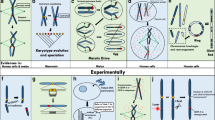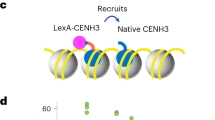Abstract
A mammalian artificial chromosome (MAC) may be assembled through the juxtapposition of three kinds of DNA elements: a centromere, several DNA replication origins, and two telomeric repeats. The resulting structure should be able to carry and express one or more selected genes (transgenes), introduced for specific purposes. The minimal length is unknown, but may be of several Mb.
Of its basic elements, the telomeres may present lesser problems, in view of their simple composition and organization. Centromeres could be an issue, given their many unknowns. Mammalian DNA replication origins are at present poorly characterized, but it is expected that at least one may be contained within the MAC components, especially the transgene. Their overall assembly may require a combination of in vivo and in vitro approaches.
A promising strategy aims at constructing two telomeric arms of a MAC, one of which may include the transgene. The two novel arms could acquire a functional centromere through recombination with the two arms of a resident chromosome. Alternatively, if the two telomeric constructs are also endowed with properly placed and oriented centromeric sequences, a centromere may be rescued in vivo by homologous recombination with the external parts of the centromere of the resident chromosome. Positive selection for the artificial arms and counterselection against the resident arms should facilitate the assembly process.
The assembly of such construct would not change the ploidy number of the host cell. After loading of a transgene, however, the resulting MAC may be isolated and transferred into an expression cell, where it may represent a novel chromosomal element. In this case untoward effects to the host cell may derive from an ensuing dosage effect for the transgene(s) rather than from the presence of a MAC per se.
A MAC may contribute to a deeper understanding of the structural requirements for chromosomal function and evolution as well as the mechanism of chromatin formation. It should also help in the development of second generation vectors for transfer of Mb-long DNA sequences, as required for properly regulated mammalian gene function as well as, possibly, for therapy.
Similar content being viewed by others
References
Aladjem MI, Groudine M et al. (1995) Participation of the human beta-globin Locus Control Region in initiation of DNA replication. Science 270, 815–819.
Bayne RAL, Broccoli D et al. (1994) Sandwiching a gene within 12 kb of a functional telomere and alpha satellite does not result in silencing. Hum Molec Gen 3, 539–546.
Brown WRA (1992) Mammalian artificial chromosomes. Curr Opin Gen Dev 2, 479–486.
Brown KA, Barnett MA et al. (1994) Dissecting the centromere of the human Y chromosome with cloned telomeric DNA. Human Mol Genetics 3, 1227–1237.
Burke DT, Carle GF and Olson MV (1987) Cloning of large segments of exogenous DNA into yeast by means of artificial chromosome vectors. Science 236, 806–812.
Carine K, Solus J et al. (1986) Chinese hamster cells with a minichromosome containing the centromere region of human chromosome 1. J Somat Cell Molec Gen 12, 479.
Chang JC, Lui D and Kan YW (1992) A 36-base pair core sequence of locus control region enhances retrovirally transferred human beta-globin expression. Proc Natl Acad Sc USA 89, 3107–3110.
Cohen D, Chumakov I and Weissenbach J (1993) A first generation physical map of the human genome. Nature 366, 693–701.
Crystal RG (1995) Transfer of genes to humans: early lessons and obstacles to success. Science 270, 404–410.
Davies NP (1995) How long should we wait for a big MAC? Gene Therapy 2, 299–300.
den Dunnen JY, Grootscholten PM et al. (1989) Topography of the DMD gene: FIGE and DNA analysis of 194 cases reveals 115 deletions and 13 duplications. Amer J Hum Gen 45, 835–847.
Farr C, Stevanovic M et al. (1992) Telomere-associated chromosome fragmentation: applications in genome manipulation and analysis. Nature Gen 2, 275–282.
Farr C, Bayne RAL et al. (1995) Generation of a human X-derived minichromosome using telomere-associated chromosome fragmentation. EMBO J 14, 5444–5454.
Ferretti L, Raimondi E, Sgaramella V et al. (1991) Molecular cloning of DNA from a sorted human minichromosome. Gene 99, 229–234.
Garagna S, Broccoli D, Redi CA, Searle JB, Cooke HJ and Capanna E (1995) Robertsonian metacentrics of the house mouse lose telomeric sequences but retain some minisatellite DNA in the pericentromeric area. Chromosoma 103, 685–692.
Gavaghian H (1995) A shot in the arm for gene therapy company. Nature Med 1, 392.
Gerrard AJ, Hudson DL et al. (1993) Towards gene therapy for Haemophilia B using primary human keratinocytes. Nature Gen. 3, 181–184.
Glorioso J (1995) Gene therapy 1995: developments on the horizon. Gene Therapy 2, 81–83.
Godwin AR, Bollag DM et al. (1994) Spontaneous and restriction enzyme-induced chromosome recombination in mammalian cells. Proc Natl Acad Sci USA 91, 12554–12558.
Hahnenberger KM, Baum MP et al. (1989) Construction of a functional minichromosome in the fission yeast Schizosaccharomyces pombe. Proc Natl Acad Sci USA, 86, 577–581.
Huxley C (1994) Mammalian artificial chromosomes. Gene Therapy, 1, 7–12.
Ioannou P, Amemiya CY et al. (1994) A new bacteriophage P1-derived vector for the propagation of large human DNA fragments Nature Gen. 6, 84–89.
Karlsson S (1991) Treatment of genetic defects in haemopoietic cell function by gene transfer. Blood 78, 2481–2492.
Kessler DA, Siegel JP et al. (1995) Regulation of somatic cell therapy and gene therapy by the Food and Drug Administration. New Engl J Med 329, 169–1173.
Kipling D, Mitchell AR et al. (1995) CEN-B binds a novel centromeric sequence in the Asian mouse Mus caroli. Molec Cell Biol 15, 4009–4020.
Larin Z, Fricker M and Tyler-Smith C (1994) De novo formation of several features of a centromere following introduction of a Y alphoid YAC into mammalian cells. Hum Molec Genetics, 5, 689–695.
Lu L, Xiao M et al. (1993) Enrichment, characterization and responsiveness of single primitive CD 34 ++ human cord blood progenitors. Blood 81, 41–48.
Marshall E (1995) Gene therapy growing pains. Science 269, 1050–105.
Monaco AP and Kunkel LM (1988) Cloning of the Duchenne/Becker muscular dystrophy gene Adv Hum genetics 17, 61–98.
Monaco AP and Larin Z (1994) YAC's, BAC's PAC's and MAC's: artifical chromosomes as research tools. Trends in Biotech 12, 280–286.
Naylor JA, Buck D et al. (1995) Investigation of the factor VIII intron 22 repeated region (int22h) and the associated inversion junctions. Hum Mol Gen 4, 1217–1224.
Partridge TA, Morgan JE et al. (1989) Conversions of mdx myofibres from dystrophin-negative to positive by infection of normal fibroblasts. Nature 337, 176–179.
Porteous DJ (1987) Chromosome mediated gene transfer: a functional assay for complex loci and an aid to human genomic mapping. Trends Gen 3, 177–182.
Plavec I, Papayannopoulou T et al. (1993) A human globin gene fused to the human globin locus control region is expressed at high levels in erythroid cells of mice engrafted with haemopoietic stem cells. Blood 81, 1384–1392.
Rainmondi E, Moralli et al. (1995) Human mini-chromosomes as potential vectors for gene therapy. J Exp Clin Canc res 14. 1, 207–209.
Reivas J, Kaeasinski J et al. (1994) The use of dermal fibroblasts in cell therapy for primary muscle disease. Gene Therapy 1, Supple. 2 A 94.
Schlessinger D (1990) Yeast artificial chromosome: tools for mapping and analysis of complex genomes. Trends in Gen 6, 248–258.
Sgaramella V (1995) Gene therapy: the artificial may improve the natural (as for chromosomes). Biology Internat Special Issue 33, 25–27.
Sgaramella V, Ferretti L et al. (1990) A procedure for cloning restriction fragments of DNA as single inserts in yeast artificial chromosomes. Biochem Intern 20, 503–510.
Sirota L, Zlotogoya Y et al. (1981) 49, XYYYY. A case report. Clin Gen 19, 87–93.
Shizuya H, Birren B et al. (1992) Cloning and stable maintenance of 300 kb-pair fragments of human DNA in Escherichia coli using an F-factor-based vector. Proc Natl Acad Sci USA 89, 8794–8797.
Smith AJH, de Sousa MA et al. (1995) A site-directed chromosomal translocation induced in embryonic cells by Cre-lox P recombination. Nature Gen 9, 376–385.
Stamberg J and Thomas GH (1986) Unsual supernumerary chromosomes: types encountered in a referred population and high incidence of associated maternal chromosome abnormalities Hum Gen 72, 140–144.
Sun TQ, Fenstermacher TA and Vos JH (1994) Human artificial episomal chromosomes for cloning large DNA fragments in human cells. Nature Gen. 8, 33–41.
Takahashi M, Furukawa T et al. (1991) Efficient introduction of a gene into haemopoietic cells in S phase by electroporation. Exper Haematology 19, 343–346.
te Riele H, Maandag ER and Berns A (1992) Highly efficient gene targeting in embryonic stem cells through homologous recombination with isogenic DMA constructs. Proc Natl Acad Sci USA 89, 5128–5132.
van Deursen J, Fornerod M et al. (1995) Cre-mediated site-specific translocation between non-homologous mouse chromosomes. Proc Natl Acad Sci USA 92, 7376–7380.
Vollrath D, Davis RD et al. (1988) Physical mapping of large DNA by chromosome fragmentation. Proc Natl Acad Sci USA 85, 6027–6031.
Wagner E, Zenke M et al. (1990) Transferrin-polycation conjugates as carriers for DNA uptake into cells. Proc Natl Acad Sci USA 87, 3410–3414.
Watt F (1994) Epidermal stem cells. Gene Therapy 1, Suppl 2, 5, 1994.
Author information
Authors and Affiliations
Rights and permissions
About this article
Cite this article
Sgaramella, V., Eridani, S. Mammalian artificial chromosomes: A review. Cytotechnology 21, 253–261 (1996). https://doi.org/10.1007/BF00365348
Received:
Accepted:
Issue Date:
DOI: https://doi.org/10.1007/BF00365348




